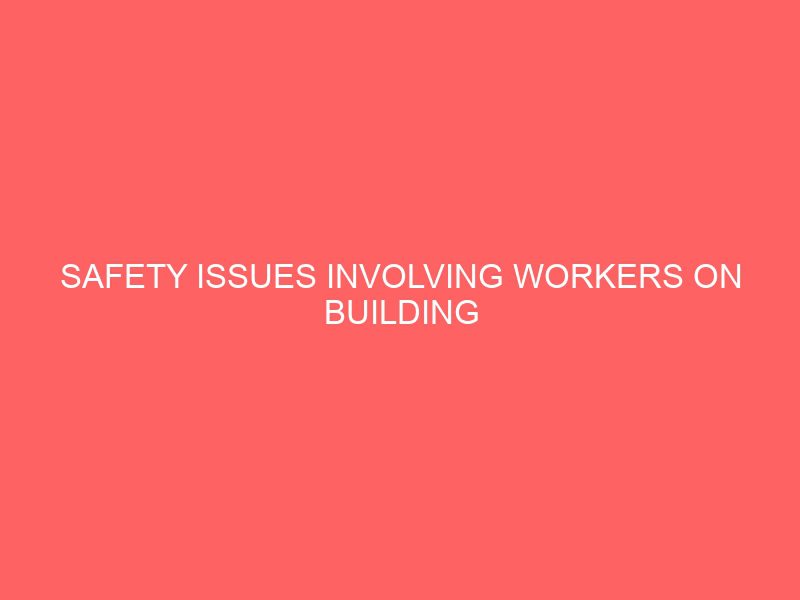Description
CHAPTER ONE
1 INTRODUCTION
1.1 Background
This research is on Safety Issues Involving Workers on Building Construction Sites in Nigeria (case study Abuja). The safety of building construction workers on building sites is paramount to achieving success in any project. Importance of safety in any kind of construction activity is unparalleled, as stated by Okoye chuks et al (2013). Only when these workers are in a sound state of mind and are physically healthy that work can go on smoothly as virtually all works on site are dependent on the workers for implementation. Occurrence of accidents or injury to workers tends to demoralize the workers and in some cases leads to suspension of construction activities.
Gray (1990), defined safety as the condition of being free from harm it is key to achieving success in construction. The building construction sector is a very hazardous one, as other construction sectors experiencing very frequent accident cases. This sector is very vital to all other industries as it provides the environment for their operation (Jimoh, 2012). Shelter is one of mans basic necessity in life, the quest for the provision of adequate housing has led to an increase in the activities of the building construction industry in Nigeria. Little or no attention is paid to the safety of the workers who see to the realization of these buildings, they are mostly illiterate and are ignorant of their rights and privileges.
Construction safety is an issue which affects the global construction industry, concerns usually arise whenever major construction activities are to take place (Hinze, 2007). The reality on ground is that accidents and injuries continually occur on construction sites, some even leading to loss of lives. Most employers fail to provide a safe and conducive working environment while in some cases the workers use the facilities inappropriately, these practices have implications to the workers themselves, the construction company and even the society at large (Ikechukwu et al., 2012). There has been much improvement in safety issues as regard to the construction industry, it should however be noted that there is room for more improvement especially in developing nations, Nigeria inclusive.
The problems experienced are not restricted to a particular country as they cut across virtually all countries construction sectors. These problems tend to be more persistent in the poor developing nations than in the more developed richer nations. The construction industry in developing nations have performed far below expectation in the area of safety, Nigeria’s situation is worse as even the national building code approved by the national executive council in the year 2006 is not being enforced effectively till date. Safety during construction is usually not given priority in most developing nations like Nigeria as it is regarded to be a burden (Godwin, 2011).
Safety records in these developing counties are usually poor (Huang, 2006). Okeola (2009) stated that there are no reliable data on construction accidents in Nigeria, this is because most contractors fail to report cases of accidents to the ministerial departments in charge of such occurrences, they don’t keep proper records themselves. According to him, the Punch newspaper of July 2005 reported a case of the collapse of a four (4) storey building in Port Harcourt city, this incident led to the death of about 20 site workers. Such occurrences point to the fact that Nigerian building construction workers are constantly being made to work under unsafe conditions which pose danger to their lives. Deaths and permanent disabilities have occurred as a result of these poor standards. This shows the government needs to enforce the available regulations to check these accidents. Idoro (2011) was of the opinion that accident and injury rates in Nigeria as at the year 2006 were 2 accidents per 100 workers and 5 injuries per 100 workers, these rates were really not different between the indigenous companies and multinational companies.
A number of challenges limit the performance of the construction industry in Nigeria, they include: lack of skilled labour, shortage of materials, power cuts etc (Dantata, 2008). Despite the introduction of mechanization in construction process, and advancement in technology the reality on most sites is that about 50% of manual labour is still utilized in these processes (Okeola, 2009). This high rate of manual labour implementation perhaps plays a significant role in the high accident rates recorded among workers in the construction industry.
1.2 Statement of Problem
Accidents occur frequently on building construction sites in Nigeria with little or no documentation. While some of these accidents are caused by the workers themselves (due to illiteracy, lack of commitment to work etc) some are caused as a result of the poor or none safety measures employed by the construction companies/site staff on site. Ede (2010) in a research about the casualty trends in the cities of Lagos, Abuja and Port Harcourt reported the nature of casualties experienced in the building construction sector within the period of 2000-2010. His research revealed Lagos had the highest casualty rates followed by Abuja and lastly Port Harcourt city. This research seeks to point out safety issues faced by workers on building sites and thereafter develop effective strategies aimed at addressing them.
1.3 Scope and Objectives
This study will deal with the safety of Nigerian building construction site workers, with the purpose of establishing critical issues affecting their welfare on site, identifying shortcomings on the building sites and making recommendations towards addressing the shortcomings. This work aims at:
- Identifying the importance of safety in building construction sites.
- Controlling hazardous working conditions and unsafe worker activities.
- Evaluating construction contractor’s safety implementation programs.
The objectives are:
- Develop a theoretical framework which confronts safety issues experienced by a typical Nigerian building site worker.
- Review literature on safety issues of workers on building sites so as to get a clear picture of safety related issues experienced.
- Make appropriate recommendations which will help protect the rights and privileges of workers on Nigerian building sites.
1.4 Why Abuja
Abuja is the capital city of Nigeria, located in the centre of the country. It replaced Lagos as the capital officially on the 12th of December 1991, though Lagos is still the most populous city. Abuja and Lagos account for a large percentage of most building construction works in Nigeria when compared to other cities. The choice of Abuja for this study is because of the obvious reason of it being the nation’s capital. Being a relatively new city, it is still expanding and thus adequate construction sites exist.
Nigerian newspapers have reported a number of stories regarding accidents and casualties in Abuja building sites, this gives an embarrassing and unsafe picture of the building sector in Abuja. In April, 2014 Premium times reported a case of a 5storey building collapse in Maitama injuring four people, three of the injured were labourers. Bukola (2010) reported that 13 people died in a building in Ikole street Abuja, the building was earlier marked for demolition by the Federal capital development Authority (FCDA) because the owner had increased the number of floors from a 3-storey building to 4-storey building. They put a stop work order on the building on the 12th of December 2009 but the building collapsed before they could eventually demolish it, this critically highlights non compliance with building rules and regulations by most property developers in Abuja.
Most problems encountered on sites in Abuja can be fairly generalized to the whole country due to the synonymous nature of the construction industry in Nigeria. Therefore this will not in any way minimize the importance of the findings. A large number of multinational construction companies are also resident in Abuja.
1.5 Outline of Methodology
Background information on workers was gathered, from the information’s key problems confronting building construction sites were highlighted. With these information’s a questionnaire was developed to collect data from the sites, the data were analyzed using Statistical Package for Social Sciences 21 (SPSS 21).
The targeted respondents to the questionnaires were Contractors, Site engineers, Project managers with active sites and the site workers. A total of Eighty (80) questionnaires were issued, fifty (50) for the workers and thirty (30) for the company staff. The questionnaires were distributed and retrieved in person from the construction sites visited.
1.6 Achievements of the Study
This research revealed that virtually all building construction firms in Nigeria are privately owned and are small scale companies employing within the range of 10100 workers. The hypothesis test revealed that Nigerian building construction workers lack safety consciousness in their practice, it further revealed that the workers do not get adequate training before they start work. The compromise on the part of the building construction companies in providing the basic safety materials and facilities was also exposed.
1.7 Outline of This Study
This work is grouped into six (6) chapters, the first being the introductory part. Chapter 2 presents a detailed literature review about safety in the construction industry in general. Chapter 3 covers the Nigerian construction sector in particular. It also looks at a brief history of how building practice started in Nigeria and some causes of accidents in Nigerian construction sites, the available regulations and legislations in Nigeria are discussed here. Chapter 4 presents the methodology used in this research, structured questionnaires as well as site visits and inspections were the main sources of obtaining the information used for the study. Chapter 5 shows a breakdown of data obtained from the issued questionnaires. The analysis of the results obtained is also given in this chapter. Chapter 6 contains some suggestions and views on how safety in Nigerian building construction industry can be enhanced.








Reviews
There are no reviews yet.